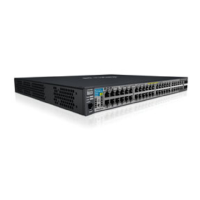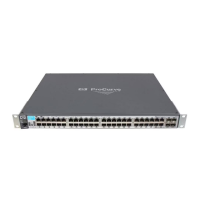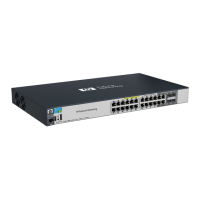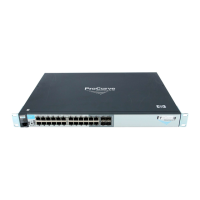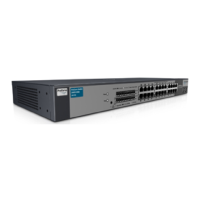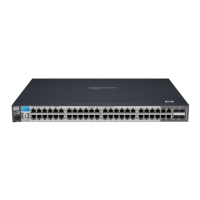Multicast Listener Discovery (MLD) Snooping
Introduction to MLD Snooping
Note that MLD snooping operates on a single VLAN (though there can be
multiple VLANs, each running MLD snooping). Cross-VLAN traffic is handled
by a multicast router.
Forwarding in MLD snooping. When MLD snooping is active, a multicast
packet is handled by the switch as follows:
■ forwarded to ports that have nodes that have joined the packet’s multicast
address (that is, MLD hosts on that address)
■ forwarded toward the querier—If the switch is not the querier, the packet
is forwarded out the port that leads to the querier.
■ forwarded toward any multicast routers—If there are multicast routers
on the VLAN, the packet is forwarded out any port that leads to a router.
■ forwarded out administratively forwarded ports—The packet will be
forwarded through all ports set administratively to forward mode. (See
the description of forwarding modes, below.)
■ dropped for all other ports
Each individual port’s forwarding behavior can be explicitly set using a CLI
command to one of these modes:
■ auto (the default mode)—The switch forwards packets through this port
based on the MLD rules and the packet’s multicast address. In most cases,
this means that the switch forwards the packet only if the port connects
to a node that is joined to the packet’s multicast address (that is, to an
MLD host). There is seldom any reason to use a mode other than “auto”
in normal operation (though some diagnostics may make use of “forward”
or “block” mode).
■ forward—The switch forwards all IPv6 multicast packets through the
port. This includes IPv6 multicast data and MLD protocol packets.
■ block—The switch drops all MLD packets received by the port and blocks
all outgoing IPv6 multicast packets through the port, except those packets
destined for well known IPv6 multicast addresses. This has the effect of
preventing IPv6 multicast traffic from moving through the port.
Note that the switch floods all packets with “well known” IPv6 multicast
destination addresses through all ports. Well known addresses are permanent
addresses defined by the Internet Assigned Numbers Authority
(www.iana.org). IPv6 standards define any address beginning with FF0x/12
(binary 1111 1111 0000) as a well known address.
Listeners and joins. The “snooping” part of MLD snooping arises because
a switch must keep track of which ports have network nodes that are MLD
hosts for any given multicast address. It does this by keeping track of “joins”
on a per-port basis.
7-5

